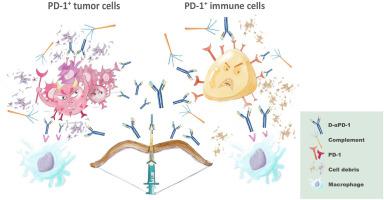Journal of Controlled Release ( IF 10.5 ) Pub Date : 2022-07-15 , DOI: 10.1016/j.jconrel.2022.07.010 Yujia Zhai 1 , Shuyun Dong 1 , Haojia Li 2 , Yue Zhang 2 , Paul Shami 3 , Mingnan Chen 1

|
PD-1 immune checkpoint has been intensively investigated in pathogenesis and treatments for cancer and autoimmune diseases. Cells that express PD-1 (PD-1+ cells) draw ever-increasing attention in cancer and autoimmune disease research although the role of PD-1+ cells in the progression and treatments of these diseases remains largely ambiguous. One definite approach to elucidate their roles is to deplete these cells in disease settings and examine how the depletion impacts disease progression and treatments. To execute the depletion, we designed and generated the first depleting antibody (D-αPD-1) that specifically ablates PD-1+ cells. D-αPD-1 has the same variable domains as an anti-mouse PD-1 blocking antibody (RMP1–14). The constant domains of D-αPD-1 were derived from mouse IgG2a heavy and κ-light chain, respectively. D-αPD-1 was verified to bind with mouse PD-1 as well as mouse FcγRIV, an immuno-activating Fc receptor. The cell depletion effect of D-αPD-1 was confirmed in vivo using a PD-1+ cell transferring model. Since transferred PD-1+ cells, EL4 cells, are tumorigenic and EL4 tumors are lethal to host mice, the depleting effect of D-αPD-1 was also manifested by an absolute survival among the antibody-treated mice while groups receiving control treatments had median survival time of merely approximately 30 days. Furthermore, we found that D-αPD-1 leads to elimination of PD-1+ cells through antibody-dependent cell-mediate phagocytosis (ADCP) and complement-dependent cytotoxicity (CDC) mechanisms. These results, altogether, confirmed the specificity and effectiveness of D-αPD-1. The results also highlighted that D-αPD-1 is a robust tool to study PD-1+ cells in cancer and autoimmune diseases and a potential therapeutic for these diseases.
中文翻译:

抗体介导的程序性死亡 1 阳性 (PD-1+) 细胞耗竭
PD-1免疫检查点在癌症和自身免疫性疾病的发病机制和治疗方面已得到深入研究。表达 PD-1 的细胞(PD-1 +细胞)在癌症和自身免疫性疾病研究中受到越来越多的关注,尽管 PD-1 +细胞在这些疾病的进展和治疗中的作用仍然很模糊。阐明它们作用的一种明确方法是在疾病环境中消耗这些细胞,并检查这种消耗如何影响疾病进展和治疗。为了执行消除,我们设计并生成了第一个特异性消除 PD-1 +细胞的消除抗体 (D-αPD-1)。 D-αPD-1 具有与抗小鼠 PD-1 阻断抗体 (RMP1-14) 相同的可变结构域。 D-αPD-1 的恒定结构域分别源自小鼠 IgG2a 重链和 κ-轻链。 D-αPD-1 经验证可与小鼠 PD-1 以及小鼠 FcγRIV(一种免疫激活 Fc 受体)结合。使用 PD-1 +细胞转移模型在体内证实了 D-αPD-1 的细胞消除作用。由于转移的 PD-1 +细胞(EL4 细胞)具有致瘤性,而 EL4 肿瘤对宿主小鼠来说是致命的,因此 D-αPD-1 的消耗效应也通过抗体治疗小鼠的绝对存活率得到体现,而接受对照治疗的小鼠组的绝对存活率则显着降低。中位生存时间仅约30天。此外,我们发现D-αPD-1通过抗体依赖性细胞介导的吞噬作用(ADCP)和补体依赖性细胞毒性(CDC)机制导致PD-1 +细胞的消除。这些结果总体上证实了 D-αPD-1 的特异性和有效性。 结果还强调,D-αPD-1 是研究癌症和自身免疫性疾病中 PD-1+ 细胞的强大工具,也是这些疾病的潜在治疗方法。











































 京公网安备 11010802027423号
京公网安备 11010802027423号